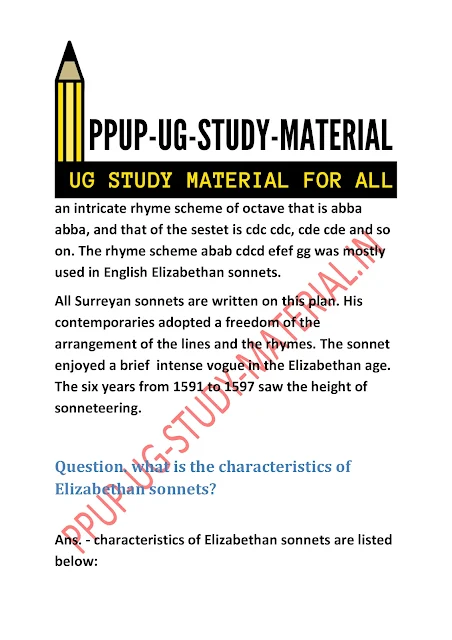Write a note on Elizabethan sonnets and sonneteers - ppup part 1 english honours notes and study material pdf
[ Write a note on Elizabethan sonnets and sonneteers | ppup part 1 english honours notes and study material pdf ]
In this BlogPost we'll cover These Topics - ppup part 1 english honours notes and study material pdf, PPUP part 1 english honours ug study material download, PPUP part 1 english honours ug study material free, PPUP part 1 english honours ug study material online, PPUP part 1 english honours ug study material pdf, PPUP part 1 english honours ug study material quora, patliputra university guess paper 2024 pdf, Elizabethan sonnet pdf, Write a note on Elizabethan sonnets and sonneteers, Elizabethan sonnet examples, Elizabethan sonnet tradition questions and answers, Elizabethan sonnet structure, Characteristics of Elizabethan sonnet, Elizabethan sonneteers, Elizabethan sonnet tradition questions and answers pdf
Introduction to Write a note on Elizabethan sonnets and sonneteers
What is a Sonnet or Italian Sonnet? | ppup part 1 english honours notes and study material pdf
What is the Meter of the Italian Sonnets?
What is the Theme or Tone of Sonnets?
Note on the Origin of Italian or Petrarchan sonnet
What is the Key Features of a Petrarchan sonnet? | ppup part 1 english honours notes and study material pdf
Note on the life and works of Major Petrarchan soneeters?
What is an Elizabethan Sonnets? | ppup part 1 english honours notes and study material pdf
Characteristics of Elizabethan sonnet | ppup part 1 english honours notes and study material pdf
Note on the Historical Background of Elizabethan Sonnets. | ppup part 1 english honours notes and study material pdf
What is Shakespearean sonnets ?
Note on the life and works of Major Elizabethan soneeters?
Difference Between Italian and Elizabethan Sonnet?
Note on Silver Poet
Conclusion for Write a note on Elizabethan sonnets and sonneteers
I hope You got what you were looking for ..reading this post Write a note on Elizabethan sonnets and sonneteers | ppup part 1 english honours notes and study material pdf ... and if you got any query ..you can comment below so we can provide you further assistance.
















![Questions. Note on the life and works of Major Petrarchan soneeters? | ppup part 1 english honours notes and study material pdf Petrarch, Italian in full Francesco Petrarca, (born July 20, 1304, Arezzo, Tuscany [Italy]—died July 18/19, 1374, Arquà, near Padua, Carrara), Italian scholar, poet, and humanist whose poems addressed to Laura, an idealized beloved, contributed to the Renaissance flowering of lyric poetry. Petrarch’s inquiring mind and love of Classical authors led him to travel, visiting men of learning and searching monastic libraries for Classical manuscripts. He was regarded as the greatest scholar of his age. Early life Petrarch’s father, a lawyer, had been obliged to leave Florence in 1302 and had moved to Arezzo, where Petrarch was born. The family eventually moved to](https://blogger.googleusercontent.com/img/b/R29vZ2xl/AVvXsEhXZfZLThrw6XPf7V0z8Jds6qXgsskGnFVJOj1N7s6QD5u7hmHLhTjvkXubzZcpY3MSXWUCpvvqBiM4JzbWqSO2dNxoBTU7ldPdqjm4jDDBNakQALk46PbveYuXbEE_AyihAJo6PrqONlhg5p7x9uBGIWsLl64j_56vpeMZHpvT7qOwVM5Z_fwHrTlF/w452-h640-rw/Write%20a%20note%20on%20Elizabethan%20sonnets%20and%20sonneteers-14.jpg)

















































No comments